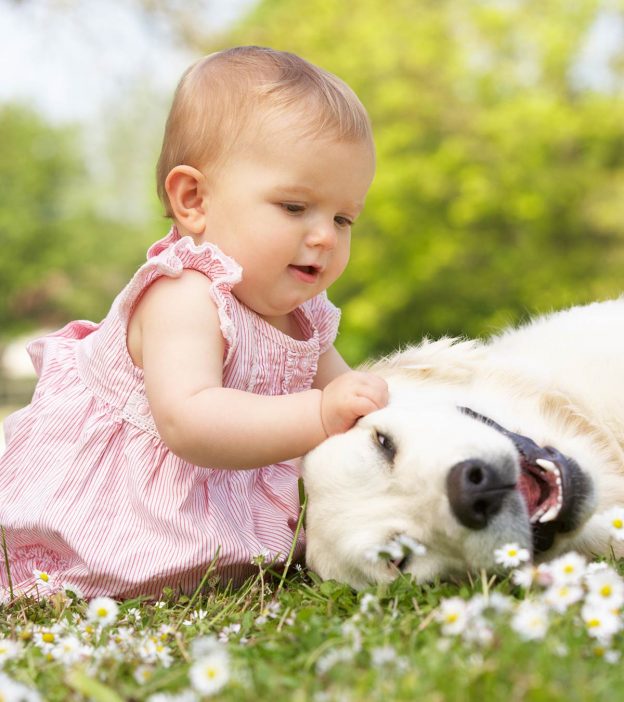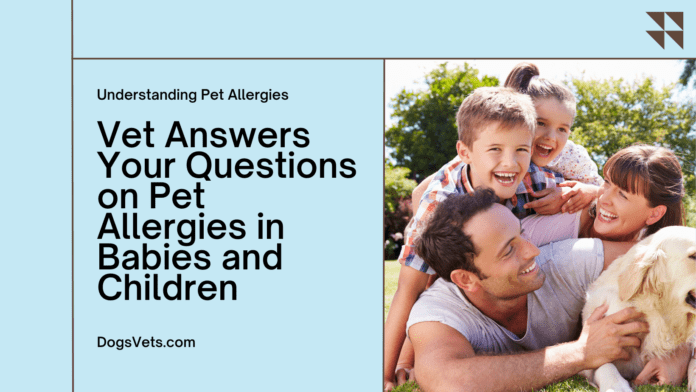Last Updated on May 11, 2024 by Dogs Vets
Pet Allergies in Babies and Children: Vet Answers Your Questions
When it comes to our little ones, their health and well-being are always our top priority. As parents, we strive to create a safe and nurturing environment for them.
However, what happens when our furry friends and their dander become a cause for concern? In this article, we will explore the topic of pet allergies in babies and children and provide answers to some common questions.
Bringing a furry friend into your family can be a joy-filled experience, but for some children, the excitement comes with a sniffling, itchy downside: pet allergies. If you’re expecting a little one or have a child who adores animals, understanding pet allergies is crucial.
This comprehensive guide, informed by veterinary expertise, addresses your concerns, sheds light on the furry culprits, and offers practical advice for navigating this common challenge.

Understanding Pet Allergies
Pet allergies occur when a child’s immune system reacts to certain proteins found in pet dander, saliva, or urine. The most common pet allergens are proteins found in cat and dog dander. It’s important to note that pet allergies are not limited to just cats and dogs; other animals like rabbits, guinea pigs, and even birds can also trigger allergic reactions.
Imagine your child’s eyes watering after snuggling a fluffy cat, or their nose turning into a faucet during playtime with the family dog.
These are telltale signs of a pet allergy, an immune system response to specific proteins found in animal dander (dead skin flakes), saliva, or urine. While pet allergies can develop at any age, they’re more common in children, affecting roughly 10% globally.
The Sneaky Culprits: Which Pets Trigger Allergies?
While cats are often blamed, any furry (or feathered) friend can trigger allergies. Here are the top contenders:
- Cats: Their dander, containing the Fel d 1 protein, is a major culprit.
- Dogs: While less common than cats, specific dog breeds like Golden Retrievers and Labrador Retrievers can trigger allergies.
- Small Mammals: Rabbits, guinea pigs, and hamsters can also cause allergic reactions.
- Birds: Feather dust and dander from birds like parrots can be problematic.

Identifying Pet Allergy Symptoms
Recognizing the signs of pet allergies in babies and children can be challenging, as the symptoms can vary from child to child. Some common symptoms include:
- Sneezing and coughing
- Runny or stuffy nose
- Watery and itchy eyes
- Skin rashes or hives
- Asthma-like symptoms, such as wheezing and difficulty breathing
If you notice any of these symptoms after your child interacts with a pet, it’s essential to consult a pediatrician or allergist for a proper diagnosis.
Managing Pet Allergies
While it may be heartbreaking to think about parting ways with your beloved pet, there are steps you can take to manage pet allergies without saying goodbye:
- Keep the pet out of the child’s bedroom: By creating an allergen-free zone, you can help minimize exposure during sleep.
- Frequent cleaning: Regularly vacuuming carpets, dusting surfaces, and washing bedding can help reduce the presence of pet allergens in your home.
- Air purifiers: Investing in a high-quality air purifier can help filter out pet allergens from the air.
- Wash hands and clothes: Encourage your child to wash their hands after petting or playing with animals and change their clothes to minimize allergen transfer.
- Consider hypoallergenic pets: Certain breeds of cats and dogs are considered hypoallergenic, as they produce fewer allergens. However, it’s important to note that individual reactions may still vary.

Living with Pet Allergies: Striking a Balance
The presence of a pet shouldn’t come at the cost of your child’s well-being. Here are tips for finding balance:
- Open Communication: Talk to your child about their allergy and involve them in managing it.
- Consider Alternative Pets: Fish, reptiles, or hypoallergenic dog breeds might be suitable options.
- Prioritize Hygiene: Regular pet grooming, washing hands after contact, and vacuuming frequently can help.
- Seek Support: Join online communities or connect with other families facing similar challenges.
Frequently Asked Questions
Now, let’s address some frequently asked questions about pet allergies in babies and children:
Can children outgrow pet allergies?
While it is possible for children to outgrow allergies, pet allergies tend to persist into adulthood. Regular monitoring and consultation with an allergist can help determine if the allergy has subsided.
Are there any medications available for pet allergies?
Yes, there are several over-the-counter and prescription medications that can help alleviate the symptoms of pet allergies. Antihistamines, nasal sprays, and allergy shots are some common treatment options.
Can exposure to pets prevent pet allergies?
Contrary to popular belief, exposing babies and children to pets at an early age does not prevent pet allergies. In fact, it may increase the likelihood of developing allergies in susceptible individuals.
Are there any alternative options for families with pet allergies?
If pet allergies are severe and significantly impact your child’s health, finding a new home for your pet may be the best option. However, before making this decision, consult with your pediatrician and explore other management strategies.
How can I help my child cope with pet allergies emotionally?
It can be challenging for a child to understand why they can’t spend as much time with their furry friend as they would like. Open and honest communication, involving them in pet-free activities, and providing reassurance can help them cope with their emotions.
In conclusion, pet allergies in babies and children can be managed effectively with the right precautions and guidance from healthcare professionals.
By creating an allergen-free environment and taking necessary steps to minimize exposure, you can ensure the well-being of both your child and your beloved pet. Remember, always consult with a healthcare professional for personalized advice.
Sources:
- American Academy of Pediatrics (AAP):
- Website: https://www.healthychildren.org/
- Specific resource: https://www.healthychildren.org/English/health-issues/conditions/allergies-asthma/Pages/Allergies.aspx (Focuses on children’s allergies in general)
- American College of Allergy, Asthma & Immunology (ACAAI):
- Website: https://acaai.org/
- Specific resource: https://acaai.org/resource/pet-allergies/ (Details on pet allergy diagnosis and management)
- National Institutes of Health (NIH):
- Website: https://www.nih.gov/
- Specific resource: https://www.niaid.nih.gov/diseases-conditions/food-allergy (Provides statistics on childhood allergies)

















